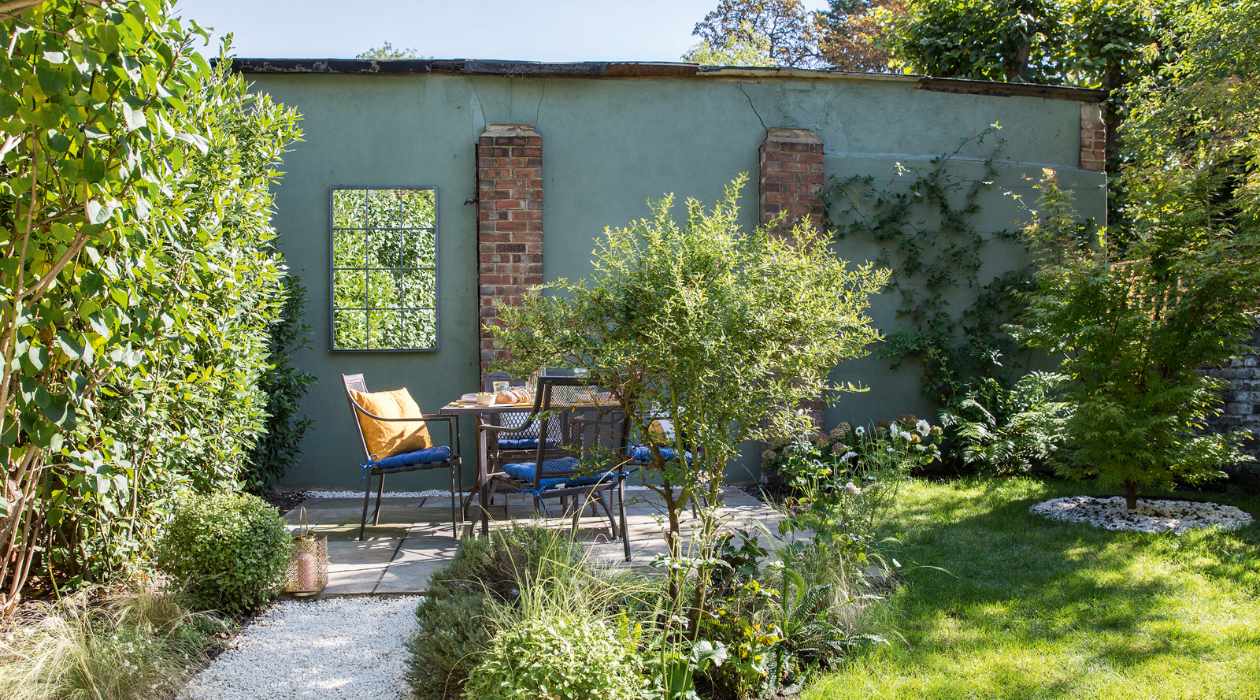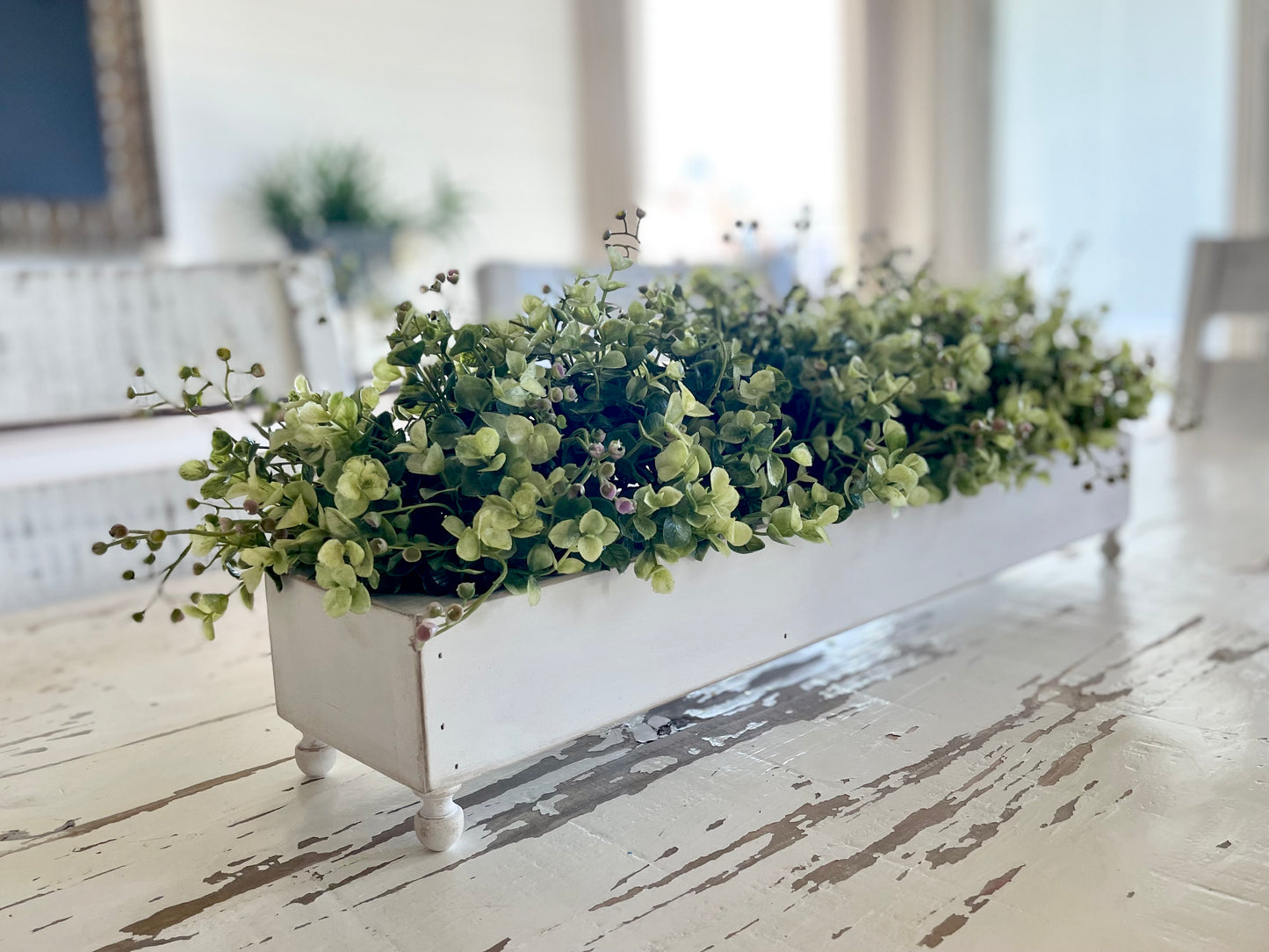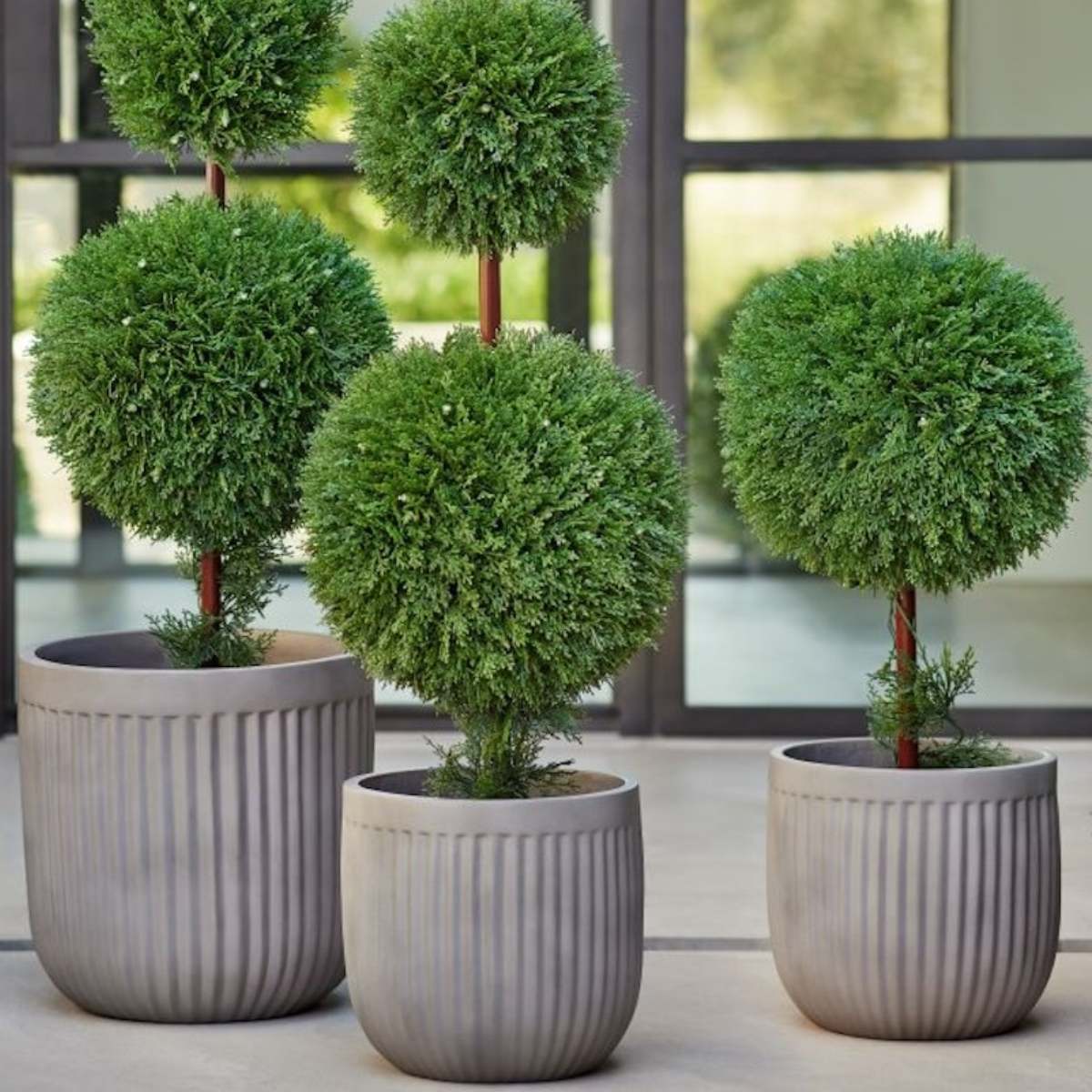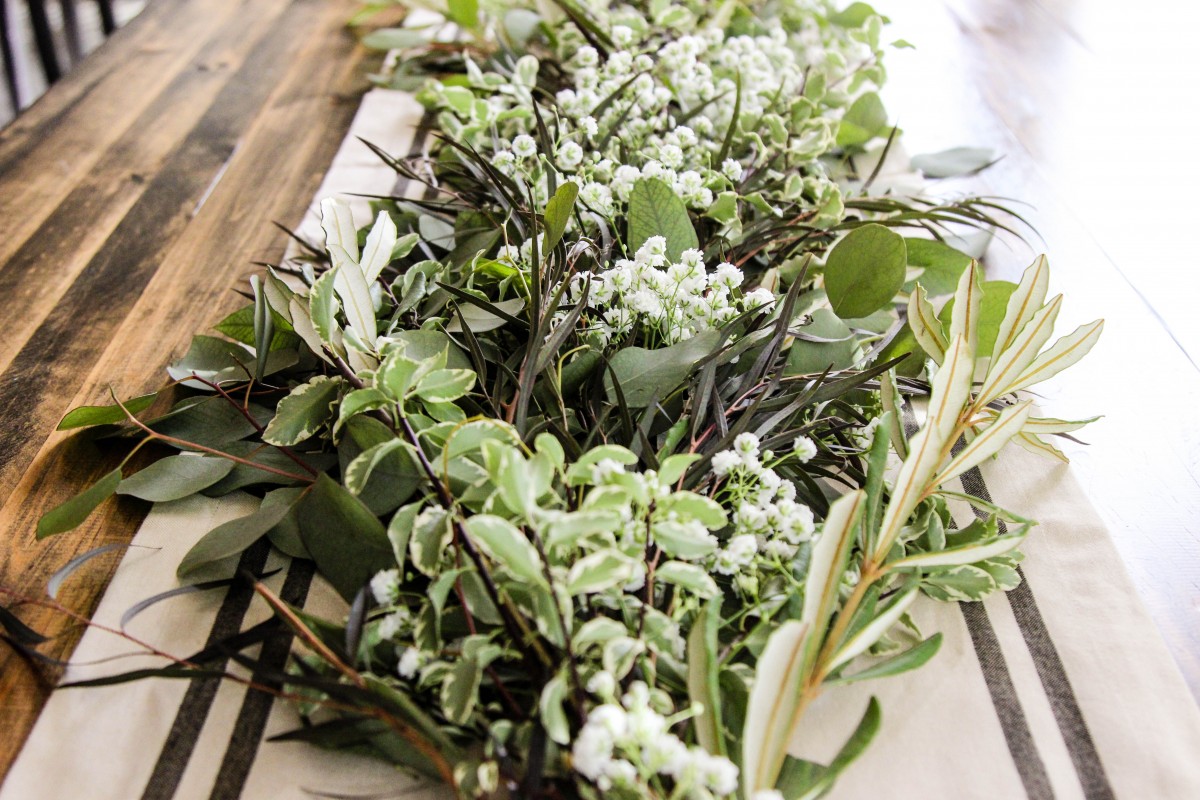Home>Garden Essentials>How To Make Outdoor Greenery


Garden Essentials
How To Make Outdoor Greenery
Modified: October 20, 2024
Learn how to create a beautiful outdoor garden with our step-by-step guide. Discover the best techniques for cultivating greenery and transforming your space into a vibrant oasis.
(Many of the links in this article redirect to a specific reviewed product. Your purchase of these products through affiliate links helps to generate commission for Storables.com, at no extra cost. Learn more)
Introduction
Welcome to the fascinating world of outdoor greenery! Whether you have a spacious backyard or a cozy balcony, adding plants to your outdoor space can transform it into a vibrant and inviting oasis. Not only do plants beautify the environment, but they also provide numerous benefits such as fresh air, relaxation, and a connection with nature.
In this article, we will explore the art of creating a stunning outdoor greenery that will captivate your senses and make your space truly come alive. From choosing the right plants to designing a beautiful landscape, we will cover all aspects to ensure your gardening journey is fruitful and rewarding.
Before diving into the details, it’s important to note that successful gardening requires a combination of knowledge, patience, and passion. Each plant has its own unique requirements, and understanding these needs will help you create an environment in which they can thrive. So, let’s embark on this green adventure together!
Key Takeaways:
- Choose the right plants for your outdoor space based on climate, personal preference, and maintenance level to create a thriving and visually appealing garden that aligns with your vision.
- Implement proper maintenance practices, including watering, fertilizing, pruning, and pest control, to ensure your outdoor greenery remains healthy, vibrant, and beautiful throughout the year.
Read more: How To Make Greenery Tomte With Greenery
Choosing the Right Plants
When it comes to outdoor greenery, selecting the right plants is crucial for a successful and thriving garden. Before you start purchasing plants, consider the climate and weather conditions in your area. Different plants have different temperature and sunlight requirements, so it’s essential to choose varieties that can withstand the conditions in your region.
Another factor to consider is your personal preference and the overall aesthetic you want to achieve. Do you prefer a colorful flower garden? Or are you more interested in a lush, tropical landscape? Take some time to research and familiarize yourself with various plant species to find the ones that align with your vision.
It’s also important to consider the space available for your outdoor greenery. If you have a small balcony, you’ll need to opt for plants that thrive in containers. On the other hand, if you have a large garden, you can consider a variety of shrubs, trees, and flowering plants.
Consider the maintenance requirements of the plants you choose. Are you willing to put in the time and effort to water, fertilize, and care for high-maintenance plants? If not, opt for low-maintenance plants that require minimal attention.
Furthermore, think about the purpose of your garden. Are you planting to attract butterflies and birds? Are you looking to grow your own fruits and vegetables? Knowing the purpose will help you select the right plants to achieve your desired outcome.
Lastly, don’t forget to consider the compatibility of different plants when planning your garden. Some plants may compete for nutrients, water, or sunlight, while others may have a symbiotic relationship. Research companion planting and choose plant combinations that benefit each other.
By carefully selecting the right plants for your outdoor greenery, you’ll set yourself up for a successful and visually appealing garden. Remember, gardening is an ongoing learning process, so be open to experimenting and adapting based on your observations and experiences.
Preparing the Outdoor Space
Before you start planting, it’s essential to prepare your outdoor space to create the ideal environment for your plants to thrive. Here are some key steps to follow:
Clear the Area: Begin by removing any weeds, debris, or unwanted plants from the area where you plan to create your outdoor greenery. This will help to prevent competition for nutrients and space.
Test the Soil: It’s important to know the quality of your soil to provide the necessary amendments. Use a soil testing kit to check the pH level and nutrient content. If needed, adjust the pH or add organic matter, such as compost or well-rotted manure, to improve the soil’s fertility.
Enhance Drainage: If your outdoor space has poor drainage, it’s crucial to address this issue before planting. Amending the soil with organic matter can help improve drainage, or you can consider installing drainage systems or raised beds to avoid waterlogging.
Consider Microclimates: Take note of the different microclimates within your outdoor space. Some areas may receive more sunlight, while others may be shadier or windier. Understanding these microclimates will help you strategically place plants based on their sun and wind preferences.
Plan the Layout: Visualize how you want your outdoor greenery to look and plan the layout accordingly. Consider the heights, colors, and textures of your chosen plants to create a visually appealing and harmonious composition. Remember to leave enough space between plants to allow for growth and maintenance.
Create Pathways and Borders: If desired, define pathways and borders within your outdoor space using materials such as gravel, stones, or bricks. This will not only enhance the aesthetic appeal but also provide structure and organization to your garden.
Consider Watering Accessibility: Ensure that you have easy access to water sources within your outdoor space. Installing irrigation systems or placing water barrels can help provide consistent and convenient watering for your plants.
Install Garden Structures: If you’re planning to include climbing plants or support structures, such as trellises or arbors, install them before planting. This will enable you to properly position and secure the structures without disturbing the roots of established plants.
By thoroughly preparing your outdoor space, you’ll provide a solid foundation for your plants to grow and flourish. Take the time to plan and execute these steps, and you’ll be rewarded with a well-prepared garden that sets the stage for a beautiful outdoor greenery.
Soil and Fertilizer Requirements
The health and vitality of your outdoor greenery depend greatly on the quality of the soil and the nutrients it provides. Understanding soil composition and implementing proper fertilizer practices are key to ensuring your plants receive the essential elements they need to thrive. Here are some important considerations:
Soil Types: Different plants have different soil preferences, so it’s essential to understand the soil type in your outdoor space. The three main soil types are sandy, loamy, and clay. Sandy soil drains quickly but may require more frequent watering, while clay soil retains moisture but may be prone to drainage issues. Loamy soil is considered ideal, as it provides good drainage while retaining moisture and nutrients.
Soil Testing: Conduct regular soil testing to assess its pH level and nutrient content. This will help you determine if any amendments are required to optimize soil fertility. Testing kits are readily available at garden centers or through online retailers.
Amending the Soil: If the soil in your outdoor space is lacking in nutrients or has an imbalanced pH level, amendments can help improve its condition. Adding organic matter such as compost, well-rotted manure, or leaf mold can enhance soil fertility, improve its structure, and promote microbial activity.
Fertilizer Application: While organic amendments can provide a good foundation for healthy soil, additional fertilization may be necessary to ensure your plants receive adequate nutrients. Choose a fertilizer that is appropriate for the specific requirements of your plants, taking into account factors such as the plant’s growth stage and nutritional needs.
Timing and Frequency: Follow the instructions on the fertilizer packaging for the recommended timing and frequency of application. Generally, it’s best to fertilize plants during their active growing season to support robust growth and flowering. However, be cautious not to over-fertilize, as this can lead to nutrient imbalances or burn the plants’ roots.
Organic vs. Synthetic Fertilizers: Consider using organic fertilizers whenever possible, as they promote long-term soil health and sustainability. Organic fertilizers release nutrients slowly, providing a more balanced and natural approach to feeding your plants. However, synthetic fertilizers can be useful in providing specific nutrients quickly and efficiently, especially in cases where plant deficiencies need to be addressed promptly.
Application Methods: There are various methods for applying fertilizer, such as top-dressing, side-dressing, or incorporating it into the soil during planting. Choose the application method that best suits the specific needs of your plants and the fertilizer you are using.
Remember, the goal is to maintain a healthy balance in the soil, providing your plants with the nutrients they require while preserving the overall ecosystem. Regular soil testing, appropriate amendments, and mindful fertilizer practices will contribute to the long-term success and vitality of your outdoor greenery.
Watering and Drainage
Proper watering and drainage are essential for the health and survival of your outdoor greenery. Understanding the water requirements of your plants and implementing effective drainage practices will help prevent issues such as root rot and waterlogging. Here are some key considerations:
Watering Needs: Different plants have different water requirements, so it’s important to research and understand the specific needs of your chosen plants. Factors such as weather conditions, soil type, and stage of plant growth can also affect the frequency and amount of water needed.
Time of Day: Water your plants early in the morning or late in the afternoon when temperatures are cooler. This allows the plants to absorb water before the heat of the day evaporates it. Avoid watering during the hottest part of the day, as the water can evaporate quickly or scorch the leaves.
Deep Watering: When irrigating, aim for deep watering rather than shallow watering. This encourages the plants to develop deep root systems, which makes them more resilient and drought-tolerant. Water slowly and deeply to ensure that the water reaches the root zone rather than just wetting the surface.
Watering Methods: Choose the appropriate watering method based on your plant’s needs and the size of your outdoor space. Options include hand watering with a watering can, using a hose with a sprinkler attachment, or installing a drip irrigation system. Drip irrigation is highly efficient as it delivers water directly to the plant’s root zone, minimizing evaporation and water waste.
Avoid Overwatering: Overwatering can be just as harmful to plants as underwatering. It can lead to root rot, fungal diseases, and nutrient leaching. Monitor the moisture level of the soil and water only when necessary. Avoid letting plants sit in soggy soil for extended periods.
Drainage Considerations: Proper drainage is crucial to prevent water from pooling around the plants’ roots. If your outdoor space has poor natural drainage, consider incorporating drainage systems or raised beds to improve water flow. Amending the soil with organic matter can also help improve drainage.
Slope and Grading: If possible, plant on a slight slope or create a gentle grading in your outdoor space. This helps excess water to flow away from the plants and prevents waterlogging. Avoid planting in low-lying areas where water tends to accumulate.
Monitor Signs of Over/Underwatering: Pay attention to signs of over or underwatering, such as wilting, yellowing leaves, or stunted growth. Adjust your watering practices accordingly, keeping in mind the specific needs of each plant.
Proper watering and drainage practices contribute to the overall health and resilience of your plants. By providing the right amount of water at the right time and ensuring effective drainage, you’ll create an environment that promotes optimal plant growth and vitality.
Read more: How To Make Mailbox Greenery
Providing Adequate Sunlight
Adequate sunlight is vital for the health and growth of your outdoor greenery. Sunlight provides energy for photosynthesis, the process by which plants convert light into food. Understanding the sunlight requirements of your plants and optimizing sun exposure in your outdoor space will help ensure their thriving growth. Here are some important considerations:
Know Your Plants: Different plants have different sunlight requirements. Some thrive in full sun, requiring at least six hours of direct sunlight per day. Others prefer partial shade, where they receive a few hours of direct sunlight and dappled shade for the rest of the day. Some plants, such as ferns and certain types of moss, prefer full shade. Research the light preferences of your plants to determine the most suitable locations for them in your outdoor space.
Observe the Sun Patterns: Take note of how sunlight moves across your outdoor space throughout the day. Observe which areas receive the most and least sunlight. This will help you identify ideal planting spots for plants with specific sunlight requirements. Keep in mind that tree canopies, buildings, and other structures can create shade patterns, so consider their impact on sunlight availability.
Consider Microclimates: Microclimates within your outdoor space can affect sunlight availability. Some areas may be sunnier or shadier than others due to factors such as nearby structures or landscaping. Plan your plant placements accordingly, taking advantage of microclimates to provide the right amount of sunlight for each plant.
Rotate and Reorganize: If you have plants that require a certain amount of sunlight, but your outdoor space doesn’t provide the ideal conditions, you may need to rotate or reorganize your plants. Move them to different locations throughout the day to ensure they receive the necessary amount of sunlight. This can also help prevent one plant from shading another and affecting its growth.
Provide Shade for Delicate Plants: Some plants, especially those that prefer partial shade or are sensitive to intense sunlight, may need additional shade protection. You can provide shade cloth or create structures such as pergolas or trellises to partially cover these plants and filter the sunlight. This will help prevent leaf burn and keep them healthy.
Prune and Thin Trees and Shrubs: If trees or shrubs are casting excessive shade and hindering the sunlight for your plants, consider pruning or thinning them. This will allow more sunlight to reach the plants below. However, be cautious not to remove too much foliage, as trees and shrubs also provide valuable shade and protection from harsh sunlight.
Monitor Plant Reactions: Pay attention to how your plants respond to sunlight exposure. If a plant appears stressed, with wilted leaves or scorched foliage, it may be receiving too much direct sunlight. Conversely, if a plant is not growing or flowering well, it may be lacking sufficient sunlight. Adjust the positioning or provide shade accordingly, based on the individual needs of your plants.
By providing adequate sunlight to your outdoor greenery, you’ll facilitate their optimal growth and overall health. Understanding your plants’ sunlight requirements, observing sun patterns, and making necessary adjustments will ensure your garden thrives in its sun-kissed environment.
When making outdoor greenery, choose plants that are native to your area for easier maintenance and better chances of survival. Research the sunlight and water requirements of each plant to ensure they are compatible with your outdoor space.
Mulching and Weed Control
Mulching and weed control are essential practices in maintaining a healthy and thriving outdoor greenery. Mulch not only helps conserve moisture in the soil but also acts as a barrier against weeds, reducing competition for nutrients and sunlight. Here’s a closer look at the importance of mulching and effective weed control techniques:
Mulching Benefits:
– Moisture Retention: Mulch helps retain soil moisture by reducing evaporation. It acts as a protective layer, preventing water from evaporating too quickly and ensuring that plants have access to a consistent water supply.
– Temperature Regulation: Mulch acts as insulation for the soil, protecting plant roots from extreme temperature fluctuations. It keeps the soil cool during hot summer days and provides some warmth during cooler seasons.
– Weed Suppression: A layer of mulch acts as a physical barrier, preventing weed seeds from sprouting and competing with your desirable plants for nutrients and sunlight. It inhibits weed growth and reduces the need for manual weeding.
– Soil Fertility: Organic mulches, such as wood chips or compost, gradually break down, enriching the soil with nutrients and improving its structure. As the mulch decomposes, it releases organic matter, which feeds beneficial soil microorganisms and improves overall soil health.
Choosing and Applying Mulch:
– Organic Mulch: Choose organic mulch materials, such as wood chips, straw, or shredded leaves. These materials break down over time, adding organic matter to the soil and providing long-term benefits. Avoid using mulch made from diseased plants or invasive species.
– Apply Properly: Apply a layer of mulch around your plants, ensuring it is evenly distributed and does not touch the plant stems or trunks. A thickness of 2-3 inches is generally sufficient. Be cautious not to pile mulch too high against plants, as it can create a moist environment that promotes rot or pest infestation.
Weed Control Techniques:
– Manual Weed Removal: Regularly inspect your outdoor greenery and manually remove any visible weeds. This can be done by pulling them out by hand or using a small weeding tool. Aim to remove weeds before they have a chance to flower and spread seeds.
– Mulch Cover: Apply a thick layer of mulch around your plants to create a physical barrier that suppresses weed growth. Make sure to apply mulch after removing existing weeds to prevent them from reemerging through the mulch layer.
– Landscape Fabric: Consider using landscape fabric beneath your mulch. This fabric prevents weed growth by blocking sunlight while still allowing water and air to penetrate. However, keep in mind that landscape fabric may hinder the decomposition of organic mulch and the natural nutrient cycling process.
– Herbicides: If necessary, you can use herbicides as a last resort to control persistent or invasive weeds. However, use herbicides sparingly and strictly follow the manufacturer’s instructions to minimize environmental impact and potential harm to desirable plants.
Regular Maintenance:
– Inspect and Refresh: Regularly inspect your mulch layer for signs of weed growth or depletion. Remove any weeds that manage to emerge and add a fresh layer of mulch when needed to maintain its effectiveness.
– Stay Vigilant: Be proactive in monitoring and preventing weed growth. Regularly inspect your outdoor greenery and address any weed issues promptly to prevent them from spreading and competing with your desired plants.
By incorporating mulching techniques and implementing effective weed control measures, you’ll create a healthy and well-maintained outdoor greenery that thrives while minimizing the effort required for weed management.
Pruning and Trimming
Pruning and trimming are important practices in maintaining the health, shape, and appearance of your outdoor greenery. By selectively removing dead, damaged, or overgrown plant parts, you not only enhance the overall aesthetic appeal but also promote healthier growth and better fruit production. Here are some key considerations and techniques for effective pruning and trimming:
Benefits of Pruning and Trimming:
– Shape Maintenance: Pruning helps control the growth and shape of plants, allowing you to shape them according to your desired aesthetic. By removing excessive growth, you can maintain a neat and well-defined garden landscape.
– Deadwood Removal: Regular pruning enables the removal of dead or diseased branches, preventing the spread of pests and diseases to healthy parts of the plant. It also reduces the risk of falling branches that can cause damage or injury.
– Enhancing Flowering and Fruit Production: Some plants benefit from pruning as it stimulates new growth and enhances flowering and fruiting. By selectively removing certain branches, you can redirect the plant’s energy towards producing more blooms or larger fruits.
– Improved Air Circulation: Pruning allows for better air circulation within the plant, reducing the risk of fungal diseases. Adequate airflow helps dry out foliage quickly after rain or watering, minimizing the chances of fungal infections.
When to Prune:
– Prune During Dormancy: For most deciduous trees and shrubs, the ideal time for pruning is during their dormant period, typically in late winter or early spring. Pruning during this time allows the plant to heal and recover before the growing season begins.
– Prune Flowering Plants After Bloom: If you have flowering plants, it’s best to wait until after they bloom to prune them. This way, you can enjoy their full display of flowers before trimming away any damaged or overgrown branches.
– Continuous Maintenance Pruning: Light pruning or trimming can be done throughout the growing season to remove dead flowers, maintain shape, or control excessive growth. Avoid major pruning during hot and dry periods to prevent stress on the plants.
Pruning Techniques:
– Use Clean and Sharp Tools: Start with clean and sharp pruning tools to make clean cuts and minimize the risk of spreading diseases. Disinfect your tools with rubbing alcohol or a bleach-water solution between plants to avoid cross-contamination.
– Prune Damaged or Diseased Branches: Begin by removing any dead, damaged, or diseased branches. Make clean cuts just above the branch collar, the swollen area at the base of the branch, to encourage proper healing.
– Maintain Vase-Shaped Structure: For shrubs, aim to maintain a vase-shaped structure by removing the oldest branches at ground level. This helps improve airflow and light penetration, promoting healthy growth from the base of the plant.
– Thin Out Excessive Growth: Remove crowded or weak branches to improve the penetration of light and air. This helps reduce the risk of disease and allows the plant to allocate resources to healthy growth.
– Remove Suckers and Water Sprouts: Suckers are shoots that emerge from the base of the plant, while water sprouts grow vertically from the branches. These should be pruned as they divert energy from the main structure and can weaken the plant over time.
– Step Back and Assess: Throughout the pruning process, step back and assess the plant’s overall shape and balance. Aim for a natural and symmetrical appearance, keeping in mind the ultimate size and form of the plant.
Dispose of Pruned Material:
– Properly dispose of pruned material to prevent the spread of diseases or pests. If the material is healthy, it can be added to compost piles or shredded for use as mulch. However, if the pruned material is diseased or infested, it should be discarded to avoid contaminating other plants.
By practicing proper pruning and trimming techniques, you can ensure the health, vitality, and beauty of your outdoor greenery. Regular maintenance and thoughtful pruning will help you achieve the desired shape, promote healthy growth, and enjoy the full potential of your plants.
Pest Control and Disease Prevention
Pest control and disease prevention are crucial aspects of maintaining a healthy and thriving outdoor greenery. Pests and diseases can cause significant damage to your plants, impacting their growth, appearance, and overall health. By implementing effective prevention strategies and timely intervention, you can minimize the risk of infestations and keep your garden vibrant. Here are some key considerations:
Identifying and Monitoring:
– Keep a watchful eye on your plants and regularly inspect them for any signs of pests or diseases. Look for visible damage, such as holes in leaves, discoloration, wilting, or the presence of insects. Early detection is essential for successful intervention.
– Identify common pests and diseases that are prevalent in your region and known to target the plants in your outdoor space. Learn about their life cycles, feeding habits, and the signs of infestation or infection to recognize and address them promptly.
Proper Plant Selection:
– Choose plant varieties that are known to be resistant to common pests or diseases in your area. Selecting the right plants for your outdoor greenery can reduce the risk of infestations and make it easier to maintain a healthy garden.
– Consider using native plants, as they are often more adapted to the local environment and less susceptible to pests and diseases. Native plants also support the local ecosystem and attract beneficial insects that can help control pests naturally.
Cultural Practices:
– Practice good gardening hygiene by maintaining clean and tidy garden beds. Remove fallen leaves, debris, and dead plant material regularly, as they can harbor pests and diseases.
– Avoid overwatering, as excessive moisture can create favorable conditions for disease development. Water at the base of plants early in the morning to allow foliage to dry before evening, reducing the risk of fungal infections.
– Properly space plants to ensure good airflow, as overcrowding can promote the growth and spread of diseases. Prune branches and thin out excessive growth to improve air circulation and reduce the risk of fungal infections.
Natural Pest Control:
– Encourage beneficial insects and wildlife in your garden that prey on pests. Plant flowers that attract pollinators and beneficial insects, such as ladybugs and lacewings, which feed on aphids and other common garden pests.
– Deploy physical barriers or organic pest control methods, such as handpicking pests, using insecticidal soap or neem oil, or creating companion planting arrangements that repel pests naturally.
– Consider using biological controls, such as beneficial nematodes or predatory insects, to manage specific pests. These natural predators can help maintain a balance in the garden ecosystem.
Chemical Control:
– As a last resort, use chemical pesticides only when absolutely necessary and follow the instructions closely. Consider low-toxicity or organic options and target specific pests rather than applying broad-spectrum products that can harm beneficial insects.
– Be mindful of the potential environmental impact of chemical pesticides, and use them judiciously to minimize risks to humans, pets, and beneficial organisms.
Prompt Intervention:
– If pests or diseases are detected, take swift action to prevent further damage. Isolate plants if necessary to contain the infestation or spread of disease.
– Depending on the severity of the infestation or infection, consider pruning affected plant parts, removing entire plants, or applying appropriate treatments as recommended for the specific pest or disease.
By implementing a combination of preventive measures, natural pest control techniques, and timely intervention, you can maintain a healthy and pest-free outdoor greenery. Regular monitoring, proper plant selection, and adopting environmentally friendly practices will help you create a thriving garden that can resist and recover from potential challenges.
Read more: How To Make A Greenery Crown
Creating a Beautiful Landscape Design
Designing a beautiful landscape for your outdoor greenery goes beyond simply planting a variety of plants. It involves thoughtfully arranging elements, considering aesthetics, and creating a harmonious composition that enhances the overall appeal of your space. Here are some key considerations to help you create a stunning landscape design:
Define Your Style:
– Determine the style or theme you want to achieve in your outdoor space. Do you prefer a formal and structured design, or do you lean towards a more natural and informal look? Explore different styles, such as modern, traditional, cottage, or Mediterranean, and choose one that resonates with your personal taste and complements your surroundings.
Consider Scale and Proportion:
– Take into account the size of your outdoor space and the scale of your plants and structures. Balance is key: be mindful of the proportions between large and small plants, as well as the relation of your garden elements to the overall space. A well-balanced design creates visual harmony and prevents overcrowding or visual imbalance.
Utilize Focal Points:
– Incorporate focal points that draw the eye and add interest to your landscape. This can be a strategically placed sculpture, a captivating plant arrangement, or a water feature. Focal points create a sense of visual hierarchy and provide a focal point for the design.
Play with Colors and Textures:
– Experiment with a variety of colors and textures to add depth and visual appeal to your outdoor space. Consider the foliage colors of your plants, the blooms they produce, and how they complement or contrast with each other. Incorporating plants with varied leaf textures or adding hardscape elements can also enhance the overall aesthetic.
Create Visual Lines and Flow:
– Use lines to create a sense of direction and flow in your design. Straight lines can create a formal and structured appearance, while curved lines can add a softer and more organic feel. Take into account the natural contours of your space and use elements such as pathways, hedges, or raised beds to guide the eye and create movement in your landscape.
Consider Seasonal Interest:
– Plan for year-round beauty by selecting plants that offer interest in different seasons. Choose plants that showcase vibrant blooms in spring or summer, those with colorful foliage in autumn, or those that provide architectural interest in the winter months. This ensures your outdoor greenery is visually appealing throughout the year.
Balance Hard and Soft Landscaping:
– Achieve a harmonious balance between hardscape elements, such as pathways, walls, or patios, and the softness of your plants. Use hardscape features to create structure and delineate different areas of your garden, but be careful not to overpower the natural beauty of your plants. Soft landscaping brings life and movement to your design.
Consider Maintenance:
– Design with maintenance in mind, considering the time and effort you can dedicate to maintaining your outdoor space. Choose plants and features that align with your maintenance preferences and be realistic about the level of care they may require. Opting for low-maintenance plants or incorporating automated irrigation systems can help reduce maintenance tasks.
Seek Inspiration and Professional Help:
– Gather inspiration from magazines, books, or online resources to envision the landscape design you desire. Consider consulting with a professional landscaper who can offer expertise and help bring your vision to life while considering practical factors such as soil conditions, sunlight availability, and local climate.
Creating a beautiful landscape design for your outdoor greenery is an exciting opportunity to showcase your creativity and personalize your space. By carefully considering style, scale, focal points, colors, lines, and maintenance, you can design a stunning landscape that delights the senses and transforms your outdoor area into a captivating oasis.
Maintenance and Care Tips
To keep your outdoor greenery vibrant and healthy, regular maintenance and proper care are essential. By implementing a few key practices, you can ensure that your plants thrive and your garden remains a beautiful and inviting space. Here are some maintenance and care tips to consider:
Watering:
– Water your plants according to their specific needs. Ensure that they receive adequate moisture, especially during dry periods, but avoid overwatering, as it can lead to root rot and other issues. Water deeply and less frequently to encourage deep root growth and drought tolerance. Adjust watering frequency based on weather conditions and the individual requirements of your plants.
Fertilizing:
– Provide proper nutrition to your plants by fertilizing them regularly. Use a balanced fertilizer appropriate for the type and growth stage of your plants. Follow the recommended application rates and timing. Be cautious not to overfertilize, as this can lead to nutrient imbalances or burn the plants’ roots. Consider using organic fertilizers or slow-release options for long-term and sustainable nutrient supply.
Pruning and Trimming:
– Maintain the shape and health of your plants through regular pruning and trimming. Remove dead, damaged, or diseased branches as soon as possible to prevent the spread of pests or diseases. Prune to improve airflow, control growth, and enhance flowering or fruit production. Follow proper pruning techniques, keeping in mind the specific requirements of each plant species.
Weeding:
– Stay vigilant against weeds and address them promptly. Regularly inspect your garden beds and remove weeds manually or use appropriate herbicides when necessary. Applying mulch around your plants can help suppress weed growth and reduce the need for extensive weeding.
Mulching:
– Apply a layer of mulch around your plants to conserve moisture, suppress weed growth, and improve soil health. Ensure that the mulch depth is uniform and does not touch the stems or trunks of your plants. Replenish the mulch layer as needed to maintain its effectiveness and visual appeal.
Pest and Disease Management:
– Monitor your plants regularly for signs of pests and diseases. Identify problems early to prevent them from spreading or causing extensive damage. Implement preventive measures, such as promoting good garden hygiene, encouraging beneficial insects, and practicing proper plant care. If pests or diseases are detected, intervene promptly using appropriate controls, such as organic or chemical treatments, as necessary.
Seasonal Care:
– Adjust your maintenance practices based on seasonal requirements. Provide winter protection for cold-sensitive plants, such as covering them with frost blankets or moving them indoors. Remove fallen leaves and debris in autumn to prevent pest and disease buildup. Mulch around plants in spring to insulate the soil and prepare them for the growing season.
Garden Clean-Up:
– Regularly clean your garden beds, removing fallen leaves, debris, and dead plant material. Dispose of them properly to prevent the spread of pests and diseases. Keep your tools clean and in good condition to avoid contamination and ensure effective maintenance practices.
Observe and Adapt:
– Pay attention to how your plants respond to different care practices and environmental conditions. Observe their growth patterns, flowering or fruiting cycles, and any signs of stress. Adjust your maintenance and care routine accordingly to meet their specific needs and provide optimal conditions for their success.
Stay Informed:
– Continuously expand your knowledge and stay informed about the care requirements of your plants. Stay updated on gardening trends, techniques, and best practices by reading books, following reputable sources online, or participating in local gardening communities. Seek professional advice when needed, especially for complex issues or large-scale projects.
By following these maintenance and care tips, you’ll create an environment where your outdoor greenery can flourish. Regular attention, proper watering and fertilizing, pruning, weed control, pest and disease management, and seasonal care will help you maintain a vibrant and beautiful garden throughout the year.
Conclusion
Cultivating a thriving and beautiful outdoor greenery is a rewarding endeavor that brings both joy and tranquility to your life. By implementing the right practices and care techniques, you can create an enchanting garden that serves as a sanctuary and a source of inspiration.
Throughout this article, we have explored various aspects of outdoor greenery, including choosing the right plants, preparing the space, soil and fertilizer requirements, watering and drainage, providing adequate sunlight, mulching and weed control, pruning and trimming, pest control and disease prevention, landscape design, and maintenance and care tips.
Remember, successful gardening is a continuous learning process. As you embark on your gardening journey, take time to familiarize yourself with the needs of your plants, experiment with different techniques, and adapt your practices based on your observations and experiences. Gardening is both an art and a science, and you have the opportunity to create a masterpiece in your own backyard.
By choosing the right plants for your climate, preparing your outdoor space properly, understanding the soil and fertilizer requirements, and providing adequate care in terms of watering, pruning, and pest control, you are setting the stage for a thriving garden. Implementing effective landscape design principles will enhance the visual appeal and create a harmonious composition that speaks to the heart.
Maintaining your outdoor greenery requires ongoing attention and care. Regular watering, fertilizing, mulching, weeding, and observing for pests and diseases will help ensure your plants remain healthy and vibrant. Embrace the changing seasons and adapt your care routine accordingly, taking cue from nature as your guide.
As you embark on your journey to create and maintain an outdoor greenery, remember to enjoy the process. Gardening is a rewarding and therapeutic activity that lets you connect with nature and find solace in the beauty of your surroundings.
So go ahead, embrace your green thumb, and let your outdoor greenery flourish, bringing life, color, and tranquility to your outdoor space. Your garden will be a testament to your dedication and love for plants, and a place where memories are created and cherished for years to come.
Frequently Asked Questions about How To Make Outdoor Greenery
Was this page helpful?
At Storables.com, we guarantee accurate and reliable information. Our content, validated by Expert Board Contributors, is crafted following stringent Editorial Policies. We're committed to providing you with well-researched, expert-backed insights for all your informational needs.














0 thoughts on “How To Make Outdoor Greenery”